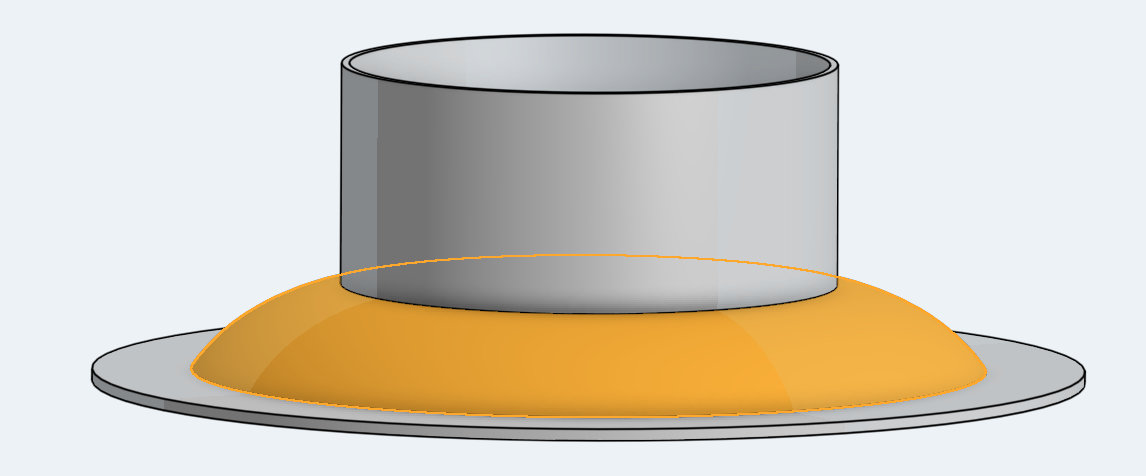Welcome to the Onshape forum! Ask questions and join in the discussions about everything Onshape.
First time visiting? Here are some places to start:- Looking for a certain topic? Check out the categories filter or use Search (upper right).
- Need support? Ask a question to our Community Support category.
- Please submit support tickets for bugs but you can request improvements in the Product Feedback category.
- Be respectful, on topic and if you see a problem, Flag it.
If you would like to contact our Community Manager personally, feel free to send a private message or an email.
How would you approach creating ribs instead of a continuous surface?
 tom_auger
Member Posts: 129 ✭✭
tom_auger
Member Posts: 129 ✭✭
A picture is worth 1000 words. An OnShape link is probably worth more but let's start with the picture and see if I can explain what I'm trying to achieve.

The above is a simple revolved shape. The centre, curved surface is the piece I'm trying to modify. Essentially I want a sparse set of "ribs" to connect the base plate to the center ring, rather than this solid monolithic curved surface. I had thought a simple solution might exist projecting a circular pattern of 2D faces onto this curve to create a repeating set of discontinuous curved surfaces that I could then shell or thicken to create the connecting "ribs". But I was unable to figure out how to project that 2D drawing onto this surface.
I also thought an "intersect" boolean operation using a series of extruded segments would work... and it did, except it only works at the part level not the surface level, so the entire part got segmented into ribs.I suppose I could duplicate the part, delete the curved face and then merge it back together, but the Constructive Solid Geometry approach seems a little un-parametric and unidiomatic for OnShape, which leads me to believe that an expert might approach this situation completely differently and I'm trying to learn as much as I can about this amazing software.
I'd love to learn how YOU would approach this challenge. I hope I've explained clearly enough what I'm trying to achieve.
(The part is being 3D printed and is designed to hold a ring of LEDs in place above a speaker, without occluding the sound too much, hence the need for sparse ribs rather tham a solid connecting surface)

The above is a simple revolved shape. The centre, curved surface is the piece I'm trying to modify. Essentially I want a sparse set of "ribs" to connect the base plate to the center ring, rather than this solid monolithic curved surface. I had thought a simple solution might exist projecting a circular pattern of 2D faces onto this curve to create a repeating set of discontinuous curved surfaces that I could then shell or thicken to create the connecting "ribs". But I was unable to figure out how to project that 2D drawing onto this surface.
I also thought an "intersect" boolean operation using a series of extruded segments would work... and it did, except it only works at the part level not the surface level, so the entire part got segmented into ribs.I suppose I could duplicate the part, delete the curved face and then merge it back together, but the Constructive Solid Geometry approach seems a little un-parametric and unidiomatic for OnShape, which leads me to believe that an expert might approach this situation completely differently and I'm trying to learn as much as I can about this amazing software.
I'd love to learn how YOU would approach this challenge. I hope I've explained clearly enough what I'm trying to achieve.
(The part is being 3D printed and is designed to hold a ring of LEDs in place above a speaker, without occluding the sound too much, hence the need for sparse ribs rather tham a solid connecting surface)
Tagged:
0
Best Answer
-
 John_P_Desilets
Onshape Employees, csevp Posts: 267
John_P_Desilets
Onshape Employees, csevp Posts: 267  @tom_auger
@tom_auger
Is this what you are looking to do? Perhaps an illustration of what the rib needs to look like will help me better understand. Thanks in advance!
5
Answers
Is this what you are looking to do? Perhaps an illustration of what the rib needs to look like will help me better understand. Thanks in advance!
In broad strokes this is what I was trying to achieve but the result is not very "expressive". For example, it might be nice to thicken up the material where the "ribs" join the two solid surfaces, or flange the base of each rib a bit etc.
At any rate, I'm more curious how others would have approached the same problem - what tools or techniques should I learn to provide more options on how to achieve similar (not necessariy identical) results?
HWM-Water Ltd
I used the term "surface" naïvely, not knowing it had a special meaning in the OnShape world. (I just watched a bunch of videos on surface modeling and now understand why my terminology may have cause confusion. I apologize.)
But for future, if you want to talk about the surface of a solid body. Just say "Face"
Absolutely Tom. Here is the example from above.
https://cad.onshape.com/documents/94b2e9a48755c2b93fa0b0fa/w/cc0d2510d2e6a87f2b1d80c4/e/39b30f3d88a12e18b9d51be9